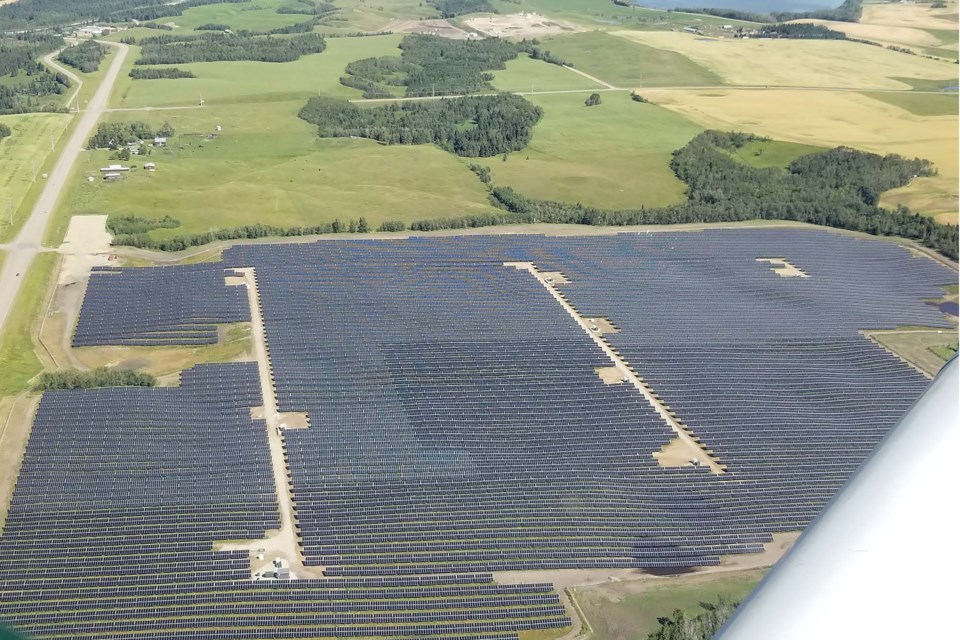Correction
This story originally stated that the solar farm's annual operating cost was $110,000. This was a typo — the cost was actually $120,000.
The story also said the farm would power 25,000 Alberta homes, based on two direct quotes from ATCO engineer Rachel Si in council chambers. Si said this assumed each home used an average of 8,900 kWh/year. While The Gazette was awaiting confirmation from ATCO, it appears this was a misstatement and that the array would actually power 2,500 homes (assuming the array produces 21,800 MWh/year) — equivalent to 9.6 per cent of the homes in St. Albert.
St. Albert will be host to a 15-megawatt solar farm in just two years, council has decided — one that will power 2,500 homes and generate some $2.42 million a year.
St. Albert council voted 6-1 June 21 to approve the project charter for a $26.1-million 15-megawatt solar farm that would be built on the Badger Lands. They also voted 6-1 on first reading of a bylaw to borrow up to $33.75 million to fund the project (the estimated cost plus 25-per-cent contingency). Coun. Sheena Hughes opposed both motions.
Council launched plans to build a potential 15-megawatt solar farm on the Badger Lands (the 72 acres of city-owned land north of Villeneuve Road) in summer 2020. At the time, the proposal was to build the farm in three five-megawatt chunks.
The proposal
City administration hired the energy firm ATCO to craft plans for the farm. ATCO came up with a design that would see some 34,350 rack-mounted bi-facial (double-sided) solar modules put on about 55 acres of the Badger site, and recommended the city build it all in one go instead of in chunks.
“You want to install the biggest solar farm you can afford to achieve economies of scale,” explained ATCO engineer Rachel Si, and so you can build one big power-grid connection instead of three smaller ones.
Si told council the Badger Lands were a good site for a solar farm as they are flat, accessible, city-owned, salt-contaminated (meaning they would require expensive cleanup for most other uses), and close to an electrical substation. The Lakeview Business District is better used for business (and limited in use due to its proximity to Big Lake), while the annexed lands are high cost (as those lands are not city-owned).
ATCO officials told council the farm would produce about 21,800 megawatt-hours of electricity a year — enough to power some 2,500 Alberta homes, or 9.6 per cent of the homes in St. Albert. (ATCO officials said "twenty-five thousand" homes, but based on their stated assumption of 8,900 kWh/home/year and the array's production, the correct figure would be "twenty-five hundred.) The U.S. EPA’s greenhouse-gas calculator suggests this would prevent some 15,449 tonnes of greenhouse-gas emissions a year — equivalent to not burning some 205 tanker trucks’ worth of gasoline.
Council heard the farm would cost about $120,000 a year to run. Power sales, carbon credits, and other revenue sources would result in net annual revenues of about $2.42 million a year, or $41 million over the 30-year life of the farm. The array would pay for itself in 12.8 years, provide stable electricity costs, and reduce the city’s carbon emissions. These predictions did not account for potential grants.
City environmental manager Christian Benson said solar has been a proven technology since the 1970s and is easy to use and maintain. Alberta has about 35 large solar farms in operation and in production, including ones at Innisfail and Fort Chipewyan.
“The economics are solid,” Benson said, with solar farms drawing considerable foreign investment to Canada.
Money-maker, says council
Hughes criticized ATCO’s projections as overly optimistic, as they assumed Canada’s carbon tax and energy prices would ramp up considerably in the coming decades.
“I’m not going to assume (Prime Minister) Trudeau is going to raise the carbon tax to $170 a tonne over time as a business model,” she said. (The federal government has said the tax would reach that level in 2030.)
Hughes said this project would merely break even if carbon taxes and energy prices stayed flat, which she argued was not worth a potential $33-million investment.
Coun. Wes Brodhead said this project was worth the investment due to its rate of return, and he was confident in those rates due to the many other communities and foreign investors that had also bought into solar.
“The reality is we need to find new mechanisms of bringing revenue into the city without twisting up the tax rate,” he said.
Heron said this project would be worth it even if it just broke even, as it would provide the commitment to green energy that foreign investors are seeking.
“I would not call these guesses,” she said, as ATCO has planned many solar farms in Alberta.
“Without guessing, I can guarantee that if we don’t find new sources of revenue, taxes will go up.”
Heron said St. Albert residents are excited about solar and would be glad council made this move to keep taxes low.
The borrowing bylaw was scheduled to return to council Aug. 30. If approved, the farm would start construction in July 2022 and be operational by April 2023.




